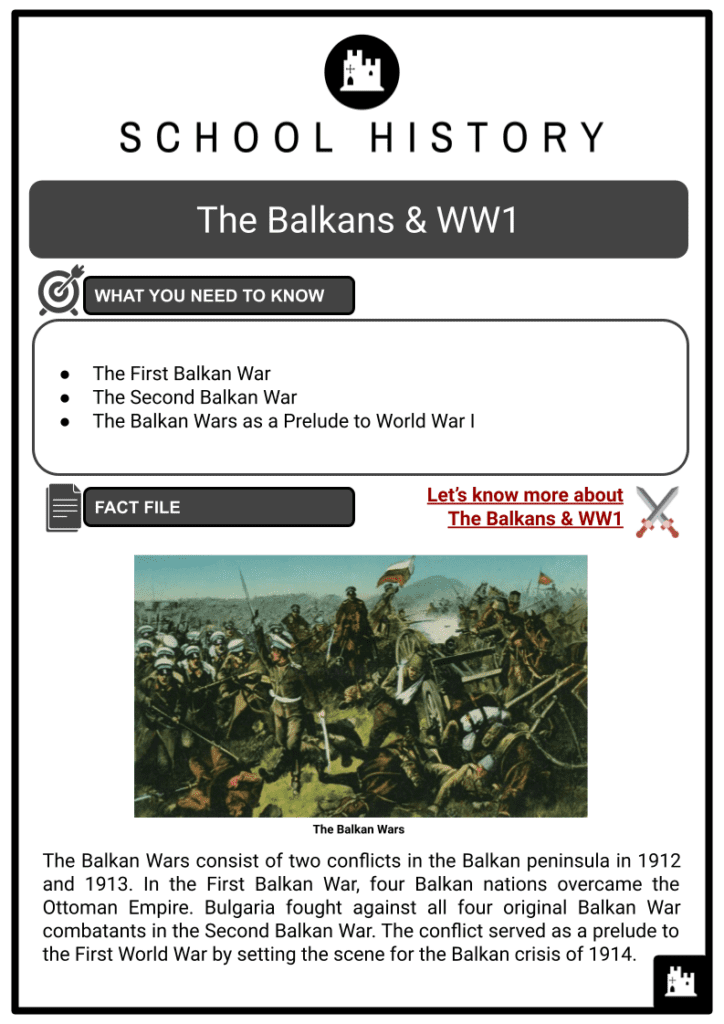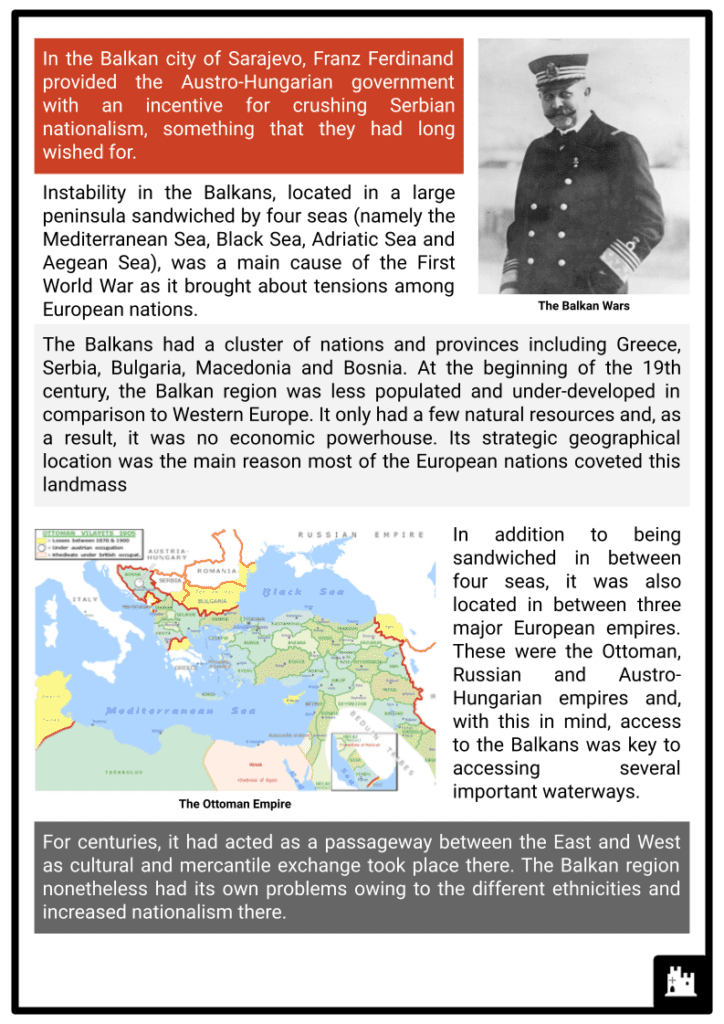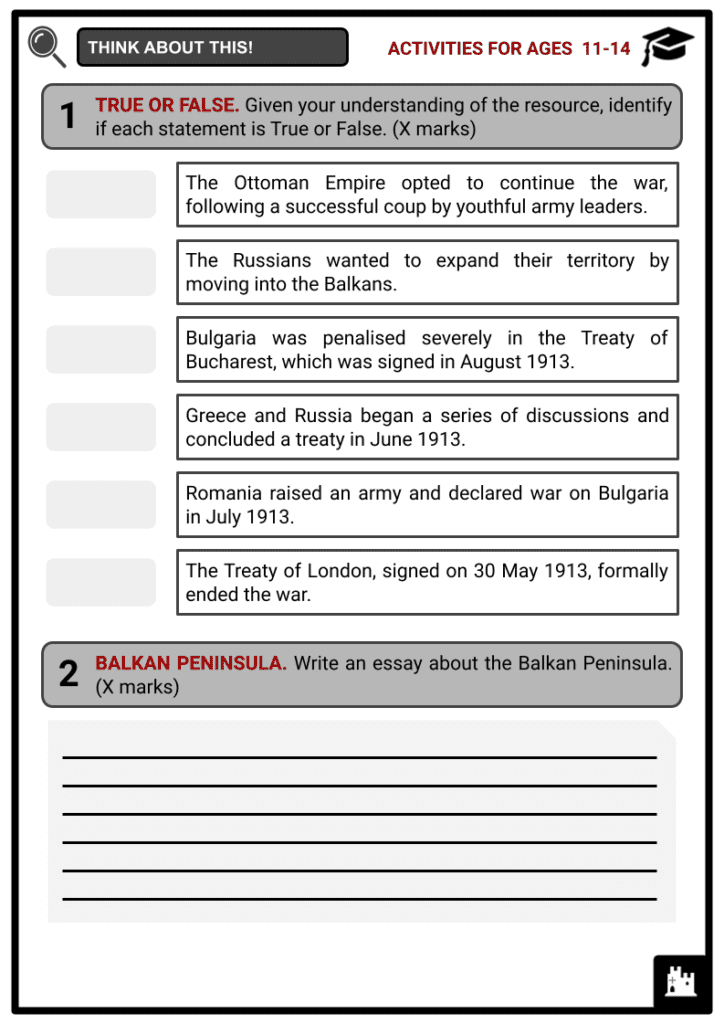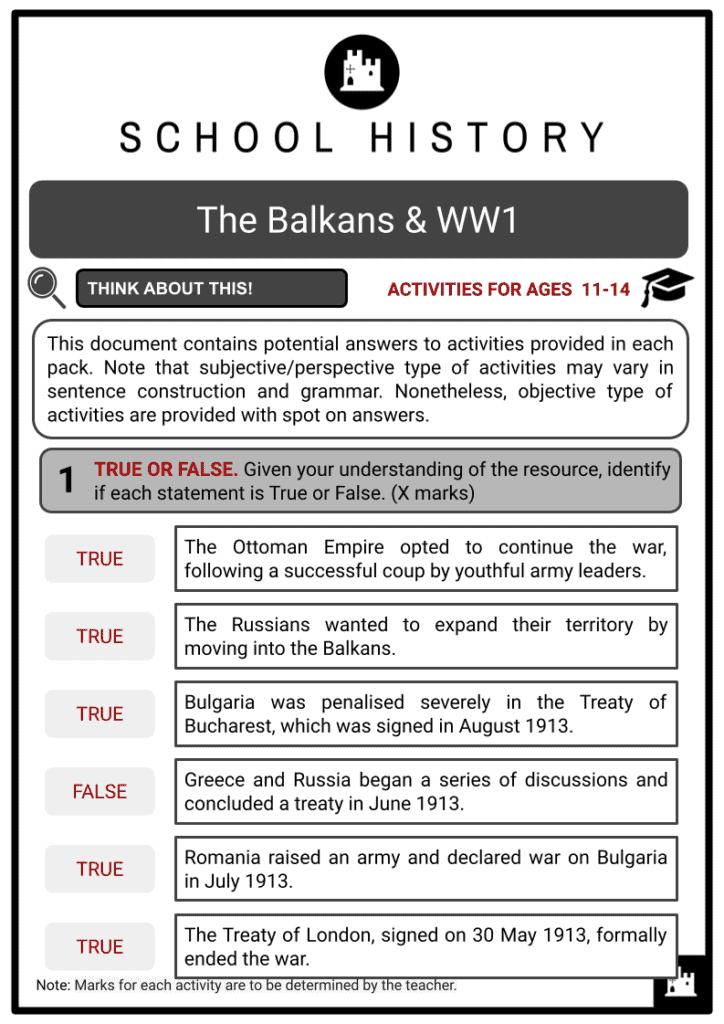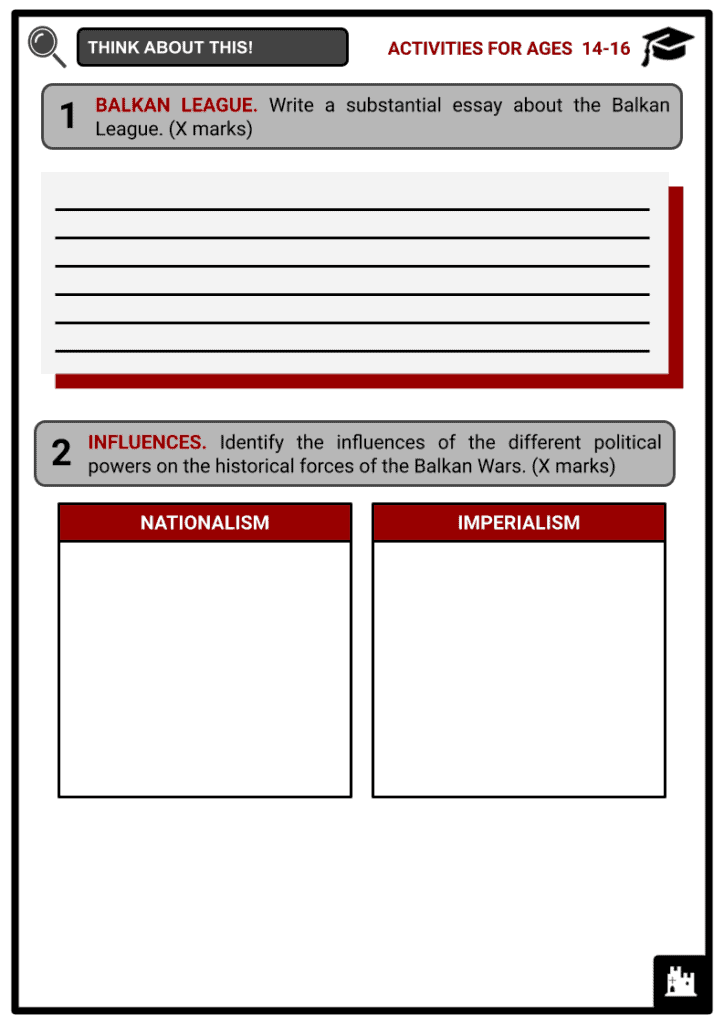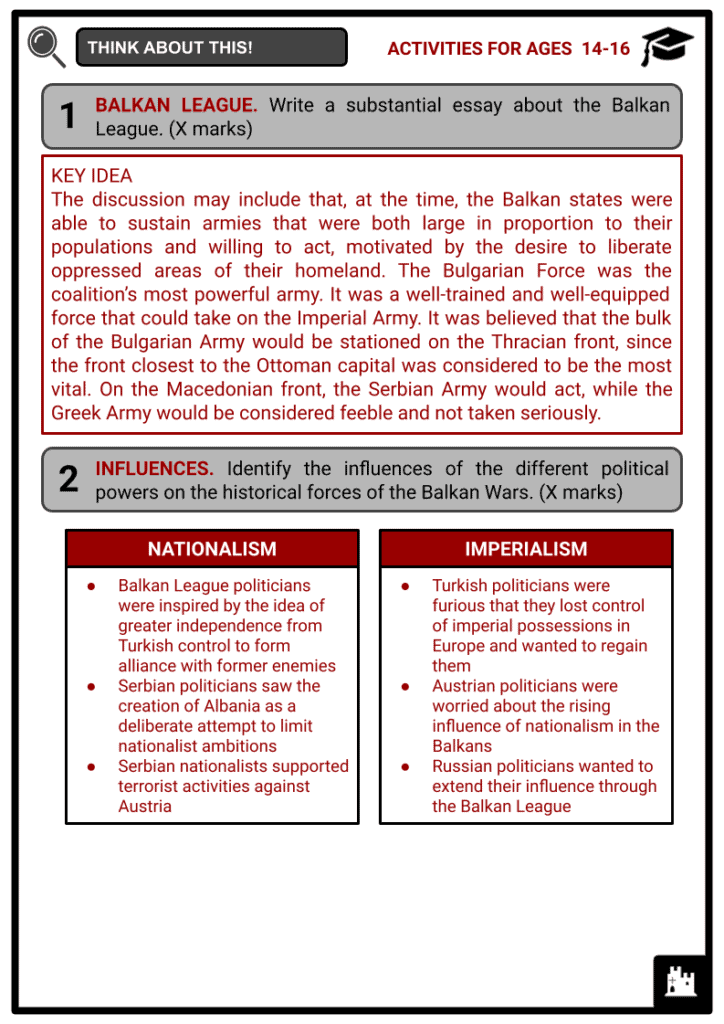Download The Balkans & WW1
Do you want to save dozens of hours in time? Get your evenings and weekends back? Be able to teach about The Balkans & WW1 to your students?
Our worksheet bundle includes a fact file and printable worksheets and student activities. Perfect for both the classroom and homeschooling!
Table of Contents
Add a header to begin generating the table of contents
Summary
- The First Balkan War
- The Second Balkan War
- The Balkan Wars as a Prelude to World War I
Key Facts And Information
Let’s find out more about The Balkans & WW1!
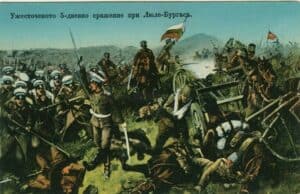
- The Balkan Wars consist of two conflicts in the Balkan peninsula in 1912 and 1913. In the First Balkan War, four Balkan nations overcame the Ottoman Empire. Bulgaria fought against all four original Balkan War combatants in the Second Balkan War. The conflict served as a prelude to the First World War by setting the scene for the Balkan crisis of 1914.
- In the Balkan city of Sarajevo, Franz Ferdinand provided the Austro-Hungarian government with an incentive for crushing Serbian nationalism, something that they had long wished for.
- Instability in the Balkans, located in a large peninsula sandwiched by four seas (namely the Mediterranean Sea, Black Sea, Adriatic Sea and Aegean Sea), was a main cause of the First World War as it brought about tensions among European nations.
- The Balkans had a cluster of nations and provinces including Greece, Serbia, Bulgaria, Macedonia and Bosnia. At the beginning of the 19th century, the Balkan region was less populated and under-developed in comparison to Western Europe. It only had a few natural resources and, as a result, it was no economic powerhouse. Its strategic geographical location was the main reason most of the European nations coveted this landmass
- In addition to being sandwiched in between four seas, it was also located in between three major European empires. These were the Ottoman, Russian and Austro- Hungarian empires and, with this in mind, access to the Balkans was key to accessing several important waterways.
- For centuries, it had acted as a passageway between the East and West as cultural and mercantile exchange took place there. The Balkan region nonetheless had its own problems owing to the different ethnicities and increased nationalism there.
The First Balkan War
- In the late 19th century, the Balkans underwent significant change and disorder. Most of Eastern Europe and the Balkan states had been part of the Ottoman Empire at its peak. Things took a turn for the worse by the late 1800s when the Ottoman Empire began crumbling. Greece, Serbia, Montenegro and Bulgaria all gained independence from Ottoman rule during this period. Britain, France, Germany and Russia, the great West European powers, had developed a strong interest in the region and this was based on what would happen to them once the Ottoman Empire fell.
- This predicament has been referred to as the ‘Eastern Question’ by historians. Acting swiftly, these great powers developed their own foreign policies and objectives. Russians, through their navy, wanted to expand their territory by moving into the Balkans and other areas that were formerly under the Ottoman Empire. They wanted to capture and control the Bosphorus, which provided shipping access to the Mediterranean. This was met with British opposition.
- The British wanted the crumbling Ottoman Empire to remain intact for as long as possible to provide some sort of buffer against the Russians, who Britain feared would attack. Germany, on the other hand, had thoughts of acquiring the Ottoman regions that were rendered bankrupt and they would attempt to make them colonies.
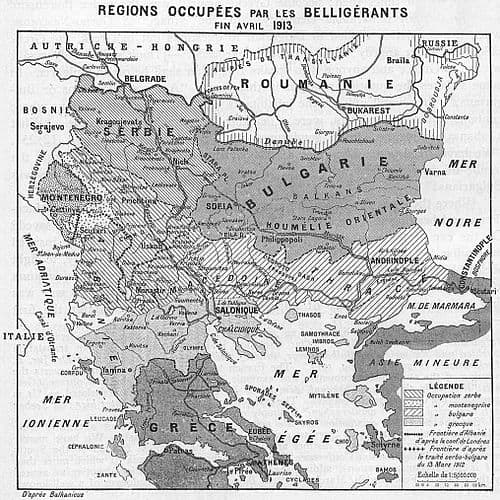
- A series of military alliances that formed a league known as the Balkan League were signed in 1912 involving several Balkan nations. These nations were incited by Russia. The main purpose of these alliances was to formally declare war on the Ottoman Empire and drive them out of Eastern Europe once and for all.
- The war began in October 1912. These signed alliances were somewhat shaky as each nation had their doubts. The Balkan states emerged victorious after eight months of intense fighting.
- In June 1913, Bulgaria, in what was considered a betrayal, launched a surprise attack on its former Balkan League allies, determined to seize the opportunity to gain some valuable territory. It proved unsuccessful, as they were quickly defeated in under a month by a unified front containing the Greeks, Serbians and Romanians. Bulgaria was penalised severely in a treaty known as The Treaty of Bucharest, which was signed in August 1913, leaving Bulgaria isolated, frustrated and hostile towards its former allies.
- The Ottoman Empire opted to continue the war in January, following a successful coup by youthful army leaders. Bulgarian forces, with the support of the Serbian Army, conquered Adrianople, while Greek forces seized Ioannina after defeating the Ottomans at the Battle of Bizani. The Montenegrin army besieged and captured Shkodra in the combined Serbian-Montenegrin theatre of operations, thereby ending Ottoman influence in Europe west of the talca line after almost 500 years. The Treaty of London, signed on 30 May 1913, formally ended the war.
The Second Balkan War
- The Second Balkan War began on 29 June 1913 when Bulgaria invaded Serbia and Greece, its erstwhile First Balkan War allies, while Montenegro and the Ottoman Empire intervened later against Bulgaria, and Romania attacked Bulgaria from the north in violation of a peace treaty.
- In the First Balkan War, the Greek army was urged to enable a Bulgarian battalion to reach Thessaloniki despite only being a day ahead of the Bulgarian 7th division. Greece agreed in exchange for a Greek unit being allowed to invade Serres.
- Since Bulgaria controlled the majority of the railway towards Thrace, Greece had also authorised the Bulgarians to control the section of the Thessaloniki-Constantinople railway that lay in Greek-occupied territory. Bulgaria was dissatisfied with the territory it held in Macedonia after the operations in Thrace ended, confirming the Greek worries, and urged Greece to give up control of Thessaloniki and the country north of Pieria, thus handing over all of Greek Macedonia. These unreasonable demands, along with Bulgaria’s unwillingness to demobilise its army after the Treaty of London ended the joint conflict with the Ottomans, alarmed Greece, which chose to keep its army deployed as well.
- On 1 June 1913, Greece and Serbia began a series of discussions and concluded a treaty. This treaty established a shared boundary between the two nations, as well as an arrangement for mutual military and diplomatic assistance in the event of a Bulgarian or Austro-Hungarian attack.
- Due to Bulgaria’s refusal to cede the fortress of Silistra as promised before the First Balkan War in exchange for Romanian neutrality, Romania raised an army and declared war on Bulgaria on 10 July, as it had officially warned Bulgaria on 28 June that it would not remain neutral in a new Balkan war. Its soldiers met minimal opposition, and by the time the Greeks agreed to an armistice with Bulgaria, they had reached Vrazhdebna, 11 kilometres from Sofia’s centre.
- The Ottomans decided to intervene after seeing the Bulgarian army’s military position. They launched an attack and, encountering little resistance, were able to reclaim all of their lands that had been surrendered to Bulgaria as part of the Sofia Conference in 1914, i.e. Thrace, with its fortified city of Adrianople, reclaimed a region in Europe that was only slightly larger than the Republic of Turkey’s current European boundaries.
Prelude to World War I
- The main beneficiaries of both Balkan Wars were the Serbs as their nation had almost doubled in size with the acquisition of parts of Macedonia and Albania and Kosovo. The occurrence of these two Balkan wars forced the great powers to rethink and reinvent their foreign policies and objectives in the region, especially Russia, which had become dependent on Serbia as a buffer against an attack from the Austro-Hungarians.
- These territorial gains had two implications on Serbia, both of which contributed to the outbreak of World War I. The first and most obvious was a staggering increase in Serbian nationalism. Serbs felt invincible after their recent triumphs. As a consequence, in the early 1900s, a number of Serb nationalist groups had formed and they flourished for the next decade. Their primary objective was to get rid of any foreign control and influence, particularly from Vienna.
- In 1908, Bosnia and Herzegovina were formally annexed by Austro-Hungary. Nationalist movements were formed in the region to oppose this move.
- They included groups like the Narodna Odbrana, meaning ‘People’s Defence’; Crna Ruka, meaning ‘Black Hand’; and Mlada Bosna, ‘Young Bosnia’.
- All these movements were formed between 1908 and 1911 and were determined to rid their people of Austro-Hungarian rule.
- Russian agents, as well as individuals in the Serbian government, public service and military, encouraged these groups.
- The majority of their activities revolved around the production of anti-Austrian propaganda and political mishaps.
- Others plotted acts of terrorism carried out by trained mercenaries.
- For example, the assassination of Archduke Franz Ferdinand in Sarajevo in June 1914, by Gavrilo Princip, a teenager who was part of Crna Ruka, the ‘Black Hand’.
- The threatened stability of Austro-Hungary was another profound consequence of Serbian expansion. In the 1870s, the Hapsburg Empire had previously surrendered significant territory to the Italians and Russians. What had happened in the Balkans between 1912 and 1913 seemed to hint at even more losses. Austro-Hungarian generals took action and began plotting tough countermeasures.
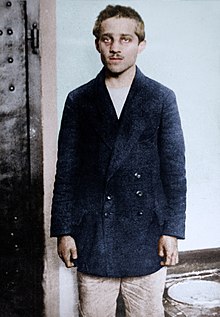
- Though their military strength and equipment lagged behind that of Germany, they believed it could easily do away with the troublesome Serbs. Franz Josef, an old Austrian emperor, was not keen on war and was conservative as he did not want to place his cherished military at risk. This changed after the assassination of his nephew and heir and the fact that a prediction by Otto von Bismarck in 1888 on where a future European war would start (the Balkans) was coming true.
- Austria-Hungary was alarmed by Serbia’s rapid territorial expansion at the expense of its regional national ambitions, as well as Serbia’s increasing prominence, particularly among Austria-Slavic Hungary’s communities. Germany, which considered Serbia a Soviet satellite, shared this concern. The two Central Powers’ determination to go to war against Serbia was largely influenced by these issues. As a result, when Archduke Franz Ferdinand of Austria, the reform-minded heir to the Austro-Hungarian monarchy, was killed by a Serbian-backed group in the 1914 July Crisis, the war soon escalated, resulting in the First World War.
Image sources
- https://upload.wikimedia.org/wikipedia/commons/5/5d/Luleburgaz_Battle_Postcard.jpg
- https://upload.wikimedia.org/wikipedia/commons/thumb/f/ff/Balkan_belligerants_1914.jpg/500px-Balkan_belligerants_1914.jpg
- https://upload.wikimedia.org/wikipedia/commons/thumb/7/7c/Gavrilo_Princip_in_his_prison_cell_at_the_Terez%C3%ADn_fortress%2C_1914_%2827324412597%29.jpg/220px-Gavrilo_Princip_in_his_prison_cell_at_the_Terez%C3%ADn_fortress%2C_1914_%2827324412597%29.jpg

